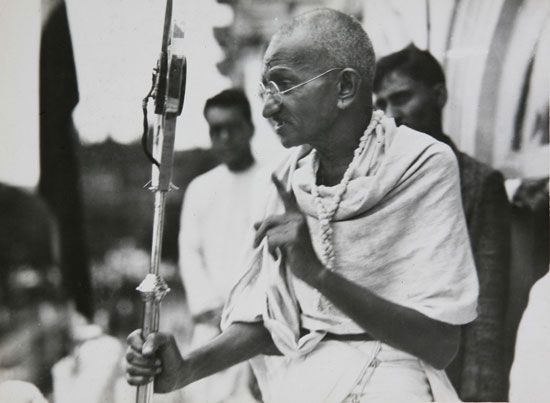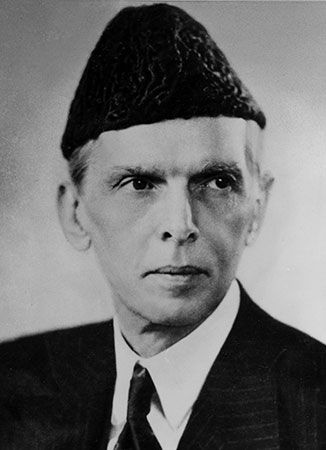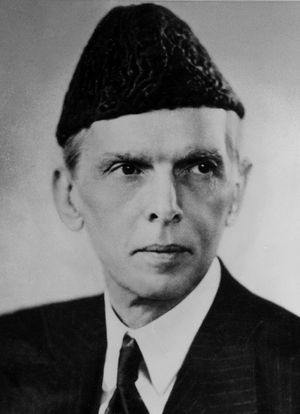Quit India Movement
Our editors will review what you’ve submitted and determine whether to revise the article.
- Also called:
- August Movement, August Kranti, or Bharat Chhodo Andolan
- Date:
- 1942
- Key People:
- Baba Amte
Quit India Movement, mass protest movement during 1942–43 against the colonial British raj’s political and military control of India. The movement, which took place against the backdrop of World War II, was initially planned by Mahatma Gandhi and his followers in the Indian National Congress (Congress Party) as a nonviolent action. However, attempts by the British authorities to prevent the protests by arresting the Congress leaders backfired and triggered an escalation of violence that, by the end of the turmoil, resulted in the deaths of at least 1,000 Indians, as well as the arrests of roughly 60,000 by the end of 1943. Though the movement was unsuccessful in its goal of forcing the immediate decolonization of India, it served as an important demonstration of anti-colonial sentiment in Indian society directed toward the British raj. Moreover, the desire of British authorities to avoid a repetition of the chaos caused by the Quit India Movement lent urgency to the decolonization of India in the postwar period.
Historical background
The Quit India Movement was not the first mass protest movement in India against British colonialism. The Indian Mutiny of 1857–59 saw Indian soldiers turn on their British army leaders, and the fighting resulted in the replacement of British East Indian Company control with direct colonial rule under the British crown beginning in 1858. Additionally, nonviolent protests for independence led by Gandhi included the noncooperation movement of 1920–22 and other acts of nonviolent civil disobedience such as the Salt March in 1930. The Quit India Movement was Gandhi’s last attempt at a satyagraha campaign against British colonial rule prior to India’s independence in 1947.
The Quit India Movement was instigated by Britain’s unilateral declaration of war on the Axis powers in 1939. In conjunction with that declaration, on September 3, 1939, Viceroy of India Linlithgow (1936–43) proclaimed that India was also at war with Germany, thereby drawing the Indian population into the conflict. With the declaration of war, Britain reinstated the Defense of India Act (1915) and essentially declared martial law in the colony. The involvement of India in the war outraged many Indian political leaders, who, despite a range of opinions on the just nature of the war, thought it was morally wrong for the British to force their subjects into the fighting (by the war’s end 2.5 million Indians had served in the British armed forces, though the majority were volunteers) without consulting Indian leadership and to use Indian resources for the effort.
As the war continued and Japanese armies swept through Britain’s Southeast Asian colonies—Singapore, Malaya (now Malaysia), and Burma (now Myanmar)—a faction of the Congress Party began to call for India to gain immediate independence from Britain in order to avoid a Japanese invasion. This faction was led by Gandhi, who was concerned that British presence in India would invite Japanese aggression. He argued that India should be allowed to make its own peace treaty with Japan and that, in the event of an invasion by Japan, Indians should resist only through nonviolent means rather than be forced by the British into military conflict.
Wanting to prevent unrest during the war, the British government sent Sir Stafford Cripps to India in March 1942 to suggest a compromise known as the “Cripps Offer,” under which Indian politicians would cooperate with the colonial government for the duration of the war and then be given dominion status—alongside Canada, Australia, and other former British colonies—and increased autonomy afterward. The offer included an “opt-out” clause allowing certain provinces to choose not to be a part of a united India—a provision that was received positively by Mohammed Ali Jinnah, whose Muslim League desired the creation of a separate Muslim-majority nation to be called Pakistan, but was viewed negatively by Gandhi and Congress, who vehemently opposed any potential partition of India. The offer was swiftly rejected by most leaders of the Indian independence movement, and Gandhi irately called the offer “a post-dated cheque on a bank that was failing.”
The perception that Britain did not take their demands seriously hardened the position of some Congress politicians and strengthened calls to engage in action toward independence. In the shadow of the growing military presence of British and American troops in India, and with the increasing food shortages in India due to the war effort, Indians continued to suffer. Japanese forces moved into the Bay of Bengal, attacked British ships, and bombed the east coast ports of Visakhapatnam and Kakinada, thus making the threat of full-scale war on Indian soil seem imminent. Gandhi became more adamant about the departure of the British colonists and less concerned about internal squabbles among Indian leadership. He notably demanded of the British in his magazine Harijan on May 24, 1942: “Leave India to God. If that is too much leave her to anarchy.”
Preparations for protest
On July 14, 1942, the Congress Party passed its “Quit India” resolution calling for an immediate end to British rule in India and authorizing Gandhi to lead a mass nonviolent protest movement if independence was not granted. The slogan “Quit India” was coined by mayor of Bombay (now Mumbai) Yusuf Meherally. When the British government failed to meet its demands, the Congress Party met in Bombay and voted on August 8 for the initiation of the Quit India Movement. During that meeting, Gandhi delivered his “Do or Die” speech, in which he famously declared: “The mantra is ‘Do or Die.’ We shall either free India or die in the attempt; we shall not live to see the perpetuation of our slavery.” Despite earlier disagreements within the party, only a small number of delegates at the meeting opposed implementing the Quit India resolution.
Others within the independence movement outside of Congress opposed the decision to engage in a widespread mass protest, notably B.R. Ambedkar and Mohammed Ali Jinnah. They viewed the Quit India resolution as a hasty power play by Gandhi to achieve Indian independence and keep the Congress Party in charge. From their perspective, independence on these terms would leave India without sufficient safeguards in place for the protection of the Dalits, Ambedkar’s constituency, and the Muslims, for whom Jinnah’s Muslim League advocated.
The morning after the Quit India resolution was agreed upon in Bombay, British authorities invoked the Defense of India Act, which permitted detention without a trial, to arrest Gandhi and dozens of other leaders of the Congress Party, including Jawaharlal Nehru, Abdul Kalam Azad, and Vallabhbhai Patel. Concern for Gandhi’s age and fear of worldwide condemnation convinced the British not to jail Gandhi, and instead they confined him in the Aga Khan’s summer palace in Pune along with his wife, Kasturba, his secretary, and some followers. The British authorities erroneously hoped they could stifle the movement by imprisoning its leaders. Meetings of Congress Party committees were forbidden, and strict press censorship prevented news of both the Quit India Movement’s approval by the Congress Party on August 8 and the arrests of August 9 from being reported in the press.
Protests and reprisals
The British authorities were, however, misguided. With the leaders of the Congress Party in jail, younger, more militant forces turned the movement in a more incendiary direction. News of the arrests leaked out in Bombay by the end of the day, and protests—both violent and nonviolent—quickly spread throughout the north of the country, particularly within the Bombay Presidency (later Maharashtra state), Bihar, and the United Provinces of Agra and Oudh (now in Uttar Pradesh state). Underground presses and radio stations launched across the country, spreading word of the mass demonstration. Nonviolent actions included marches, strikes (many of which hit war industries), and even the creation of Indian-led local government bodies.
The British government, particularly Secretary of State Leopold Amery in a radio address, further fanned the flames by justifying the arrests of the Congress leaders as a means of preventing mass violence. Amery’s description of the movement’s disruptive tactics might have inadvertently given voice and legitimacy to those very actions among more militant protesters. Also partly due to the lack of Congress leaders emphasizing nonviolence, many demonstrations turned into attacks on the British themselves and parts of the British raj’s infrastructure. Telegraph lines and railroads were destroyed, and hundreds of railway stations, post offices, and police stations were burned down or damaged.
The British response to these protests was often brutal. The military, already present in India in larger than usual numbers for the war effort, was deployed to disperse rioters, and in a few cases airplanes were instructed to fire their machine guns on the crowds from the air. Parts of the United Provinces, Bihar, the North-West Frontier, and Bengal (now West Bengal state and Bangladesh) were bombed and strafed by pilots as the British raj resolved to crush all Indian resistance as swiftly as possible. Thousands of people were killed or wounded, and roughly 60,000 arrests were made in the first few months. Most of those arrested, along with the leaders of the Congress Party, were imprisoned for the duration of World War II to prevent further protests, although Gandhi was released on May 6, 1944, because of his failing health.
Conclusion and repercussions
Since the Quit India Movement grew organically in a variety of locations and, in some places, turned into local guerrilla warfare that lasted long after its initial upsurge and suppression, it did not have a precise ending. Protests continued to spring up for months, but had largely died down by the end of 1942. By March 1943 the Quit India Movement was definitively over.
While the movement failed to achieve its stated aim of gaining India’s immediate independence from British rule, most historians argue it should not be viewed as a complete failure. The Quit India Movement demonstrated the willingness of ordinary Indians to take action to advance their independence and proved to the British government the necessity of decolonization after World War II. Global, and especially American, sentiment after the war favored Indian independence, and the British rulers thought it would be impossible, both logistically and in the court of public opinion, to quell further uprisings if they occurred during peacetime.
Another key outcome of the Quit India Movement was the strengthening of Muhammad Ali Jinnah, the Muslim League, and their efforts to create a Muslim-majority nation of Pakistan on the Indian subcontinent after British decolonization. While Congress Party leaders were in jail and membership was effectively frozen during the war, the Muslim League grew from about 100,000 members in 1941 to over 2,000,000 in 1944. With Congress inactive and their party members unable to run for local political offices, the Muslim League also took control in provinces such as Bengal and the North-West Frontier Province, which later became part of Bangladesh and Pakistan, respectively. Furthermore, by maintaining loyalty to the British and cooperating with them during wartime, Jinnah earned additional goodwill and support from the colonial authorities for the creation of a separate Muslim state. Thus, some historians consider the 1947 partition of India to have been, in part, a consequence of the Quit India Movement.














